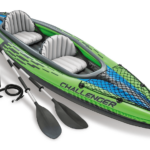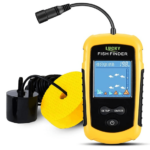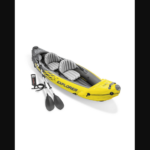It’s common for some to confuse a canoe with a kayak and vice versa. If you do know the difference between the two boats, which should you choose? Canoe vs. kayak – what are their differences? How do they compare?
The main differences between a canoe and a kayak are how you are positioned in them and how you steer. In a canoe, the paddler kneels and uses a single-bladed paddle to move the canoe. In a kayak, the paddler is seated and uses a double-bladed paddle to move the kayak.
Those who would like to go solo boating will find it easier to paddle and control a kayak than a canoe. You need to develop the skills to paddle a canoe and move forward in a straight line. It isn’t easy to do this, especially if you are going solo.
Read on to learn more about the kayak vs canoe so that you will know their differences and which is best for you.
Canoe Vs Kayak

In a canoe, the paddler propels it using a single-bladed paddle while kneeling. Whereas in a kayak, the paddler uses a double-bladed paddle while sitting.
Both the canoe and kayak have been used to transport people for thousands of years in streams, rivers, lakes, or even oceans.
They are both relatively small in size, which is why many people have used their names interchangeably. That’s part of the reason why some get confused between a canoe and kayak.
Both water-borne vessels are used in recreational boating, recreational fishing, and competitive sports. Canoe and kayak races are part of Olympic water sports.
Canoeing was introduced in the Olympics in 1924. There were only two competitors at that time. One was an American, and the other a Canadian.
The love for canoes and kayaks grew over the years. Recent Olympic Games have featured scores of canoers and kayakers competing for gold using the latest kayak and canoe boat designs.
With the growing popularity of kayaks and canoes, millions worldwide are now using them to enjoy their time on the water. They have their own reasons for choosing either the kayak or the canoe on the water.
Differences Between Canoes and Kayaks
There are slight similarities between the two, but there is also a stark difference between kayak and canoe. In fact, there are clear distinctions that you can use to differentiate kayak vs. canoe.
These boats are really different from each other, not just in their names:
Basic Design
The main difference between the canoe and kayak is their boat designs. Most canoes have open tops or open decks, while most kayaks have closed tops or closed decks.
That means paddlers inside a kayak have more freedom of movement. A kayak rower, on the other hand, has no freedom of movement below their waist.
Paddler Posture
In a canoe, the paddlers kneel inside. The paddlers can also sit if there are small benches fitted across the beam of the canoe. A kayak has an open hole where the paddler can insert himself in. Once in, they sit down on the deck with their legs stretched forward.
Boat Capacity
Some canoes are built for just one paddler. But most canoes can seat two to four people. The majority of kayaks are just for one paddler. There are only a few kayaks made for two paddlers. They are called tandem kayaks. There are no kayaks made for three paddlers.
Paddles
The paddlers of a canoe use single-bladed paddles. These are flat blade paddles they use to make their way through the water. In a kayak, the rower uses a double-bladed and curved paddle to push the boat forward.
The shape and the number of blades are important as this enables them to maneuver the boats in different ways.
Boat Weight
The majority of canoes have bigger and longer bodies. That means they are relatively heavy. Meanwhile, kayaks generally have shorter and narrower bodies. This makes them lighter compared to canoes.
On the water, canoes have more surface area that touches the water compared to the smaller kayak. In other words, there’s more buoyancy in canoes than in kayaks – hence, they are more stable on the water.
Speed
When it comes to speed, kayaks are faster than canoes, owing to their shorter and narrower bodies. They are designed to be more agile and faster than canoes. Kayaks are more nimble than canoes.
Position on the Water
Paddlers in a canoe are at a higher elevation from the water than the paddlers in a kayak. A kayak rower’s waist is nearly at the waterline, while a canoe paddler’s waist is more than a foot high from the water.
Stability on the Water
The wider and longer body of a canoe makes it more stable on the water. It cannot capsize easily. With its narrower beam and thinner body, a kayak can easily capsize.
Below is a great comparison of the kayak vs canoe, and how they are different:
What Is a Canoe?
In marine lingo, a canoe has an open cockpit.’ A cockpit is where the paddler sits and maneuvers the boat. Its gunwales, or the upper edge or section of the boat’s side, are considerably higher than the waterline.
The most common canoe has two bench-like seats positioned across the beam and is fixed on the boat’s sides. When the paddler sits in a canoe, their posterior is located at the same level or below the gunwale. Their feet would be resting flat on the bilge of the boat.
What Is a Kayak?
A kayak is a small and narrow boat usually made for just one person with a closed cockpit. There are various kayak designs, making them longer and able to accommodate two people, but their bodies are still narrow.
These variants are not the most popular kayaks known to the average American.

The term kayak came from ‘qajaq,’ an old word from Greenland. At times, kayaks can be called canoes by people who really are not aware of their differences. Most kayaks are considered sports equipment. They are mostly used for racing competitions since they are designed to be fast.
Pros and Cons of Canoes
Pros
- In general, canoes are more stable than kayaks because of their wider beams.
- A wider open-top equates to a more comfortable time on the water.
- It is easier to board and exit canoes.
- Canoes have higher gunwales, which prevent water from coming in.
- Being bigger and wider, canoes can take in a much heavier weight than kayaks. You can take more gears with you in a canoe than in a kayak.
- Canoes offer a better view of the location because of the higher sitting position.
- This boat can ensure a day of comfort and relaxation on the water.
- Portaging is much easier since you can load and unload your gear without trouble.
- A wider body means more stability and fewer chances of capsizing.
Cons
- Canoes are more difficult to maneuver than kayaks because of their wider and heavier bodies.
- Most canoes are built for two or more people. Therefore, it is more difficult to handle when going solo.
- Tracking and controlling the boat to move in a straight line is harder, especially if you are paddling alone.
- Hulls of canoes are less efficient. It requires more power to paddle it through the water.
- Being bigger, canoes are more difficult to transport.
- With open cockpits, canoe paddlers are exposed to the sun, wind, and spray.
- Canoes will sink if there is a capsize event.
Pros and Cons of Kayak
Pros
- Kayaks are very maneuverable and only require little effort to turn around.
- Kayaks only require a little effort to paddle because of their efficient hull design.
- They are faster than canoes.
- Kayaks can be rolled upright in a capsize event.
- They have dry storage holds.
- Tracking and powering the boat takes less effort because of its narrower body and double-bladed paddles.
- They are more versatile and can be used in a variety of ways.
- Being smaller and narrower, they are easier to transport.
Cons
- With a narrow and relatively long body, kayaks are less stable and are prone to capsizing.
- There is a higher chance for paddlers getting wet due to the sitting position closer to the waterline.
- It is harder to get in and out of the cockpit of kayaks.
- They are not as stable in calm waters as canoes.
- It is faster to learn the basics but more difficult to master advanced techniques.
- They have considerably lower load capacity and cannot carry as many gears as canoes.
- There is less freedom of movement for the paddlers because of the closed cockpit.
Which Is Better – Canoe vs Kayak?
Stability
Generally, canoes are more stable than kayaks because of their wider bodies. You can easily board and exit canoes. They have greater load capacities and allow you to carry more gear on the boat. Therefore, if you consider canoe vs. kayak fishing, you will be better off with a canoe.
View
Additionally, you will get a better view of your environment because of your higher seating position. However, canoes do tip easily – if given the right conditions. There are different reasons why a boat will tip over.
The most common is the uneven weight distribution on the deck. Be aware that canoes are lightweight boats. They are very sensitive to movements inside the deck as well as the movements of the water. These things make them prone to tipping over.
Maneuver
It is easier to maneuver and track a kayak than a canoe. That’s due to its slimmer body and lesser weight. Generally, they are hard to tip over. But that depends on what the situation is on the water.
Risk of Tipping
The risk of tipping is dependent on the kind of kayaking you are doing and the condition of the water you are in. Whitewater or rapid water kayaking with a sea kayak that is ultra-lightweight has greater chances of tipping over.
Determining which one is better really depends on what you are in the water for. After a relaxing time on the water with a couple of friends, your boat is the canoe. But if you want an adrenaline rush on whitewater, alone or with a friend, then your choice is the kayak.
Canoeing is fun for the family and friends. It’s time you can spend bonding and strengthening relationships.
Canoe vs Kayak Fishing – Which is Better?
Which is better for fishing? Canoeing is the one because the boat will give you stability while trying to draw your fishing line.

Kayaking is better if you don’t mind getting wet. You are venturing on more adventurous, adrenaline-rushing, and heart-pumping water activities that will test your skills as a boater. Canoe or kayak – which should you choose?
Choosing Between a Canoe or a Kayak
You will be able to determine if a canoe or a kayak is what you need if you will ask yourself the following questions:
- What type of water are you planning to paddle often?
- Are you after speed?
- Are you after greater maneuverability?
- Do you want stability on the water?
- Are you bringing a lot of gears with you?
- Do you want to bring your family or a couple of friends with you on most of your boating trips?
- Will you be boarding and exiting the boat often?
Try to answer these questions, and other questions you may be able to think about, honestly, and you will determine which of the two will better serve your objectives.
Conclusion: Kayak vs Canoe
One of the marked differences between a canoe and a kayak is in the position of the paddler. In a canoe, the paddler is kneeling, while in a kayak, the paddler is sitting.
Additionally, in a canoe, the paddler uses a single-bladed paddle to move the boat forward. In a kayak, the paddler uses a double-bladed paddle so the boat can move through the water.
For fishing, especially if you’re a beginner, you might want to choose a canoe since it’ll give you stability.
However, overall, both have pros and cons, so review them to make your adventure worth your time!


![Boundary Waters Canoe Area Wilderness [Activities, Routes, Permits] boundary waters canoe area](https://boatinggeeks.com/wp-content/uploads/2021/07/boundary-waters-canoe-area-150x150.jpg)
![Sit-In vs Sit-On Kayak [Difference Between Sit-On-Top vs Sit-In Kayaks] sit in vs sit on kayak](https://boatinggeeks.com/wp-content/uploads/2021/07/sit-in-vs-sit-on-kayak-150x150.jpg)



![Read more about the article Best Canoe Paints [5 Top Picks]](https://boatinggeeks.com/wp-content/uploads/2021/03/canoe-paint-300x200.jpg)
![Read more about the article Kayak Weight Limit [What Size Do You Need for Your Weight]](https://boatinggeeks.com/wp-content/uploads/2021/04/kayak-weight-limit-300x200.jpg)
![Read more about the article How to Canoe [10 Steps Plus How to Paddle and Steer]](https://boatinggeeks.com/wp-content/uploads/2020/12/how-to-canoe-properly-300x200.jpg)